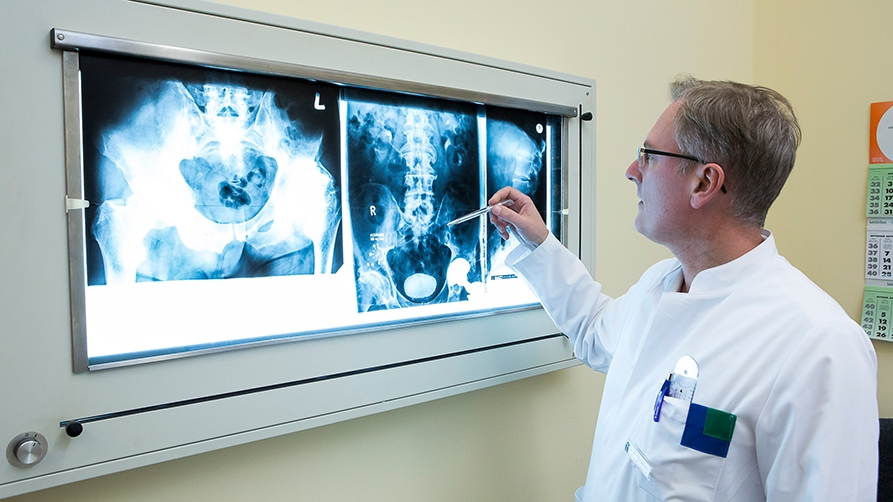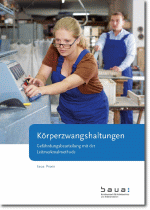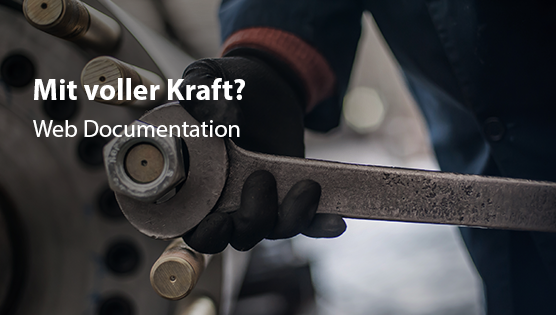Work-related musculoskeletal disorders
Physical workloads such as those imposed by unfavourable postures or the lifting and carrying of heavy loads still represent hazards to employees’ health. Consequently, these need consideration in risk assessments and preventive occupational healthcare.

Physically demanding work, such as the lifting of loads, is still common in many workplaces. In the most recent Employment Survey (Erwerbstätigenbefragung) conducted in 2018 by the Federal Institute for Occupational Safety and Health (Bundesanstalt für Arbeitsschutz und Arbeitsmedizin, BAuA) and the Federal Institute for Vocational Training (Bundesinstitut für Berufsbildung, BIBB), about 23% of employees stated they frequently had to lift and carry heavy loads. One in six frequently works in awkward postures, bending over, squatting, kneeling, lying down, or reaching above head height. More than half frequently work while standing up, and about 39% frequently perform tasks with their hands. About a quarter of all days of work incapacity are attributable to musculoskeletal disorders. Employees in manual and skilled-trade jobs and the service sector are particularly affected.
What are physical workloads?
Every form of physical workload can be regarded as a stressor within the paradigm of the “stressor-strain concept”. Such workloads are associated with motor, biomechanical, and cardiopulmonary demands, which means they place strains on the musculoskeletal and cardiovascular systems. Physical effort is part of everyday life and necessary in order to stay healthy. The musculoskeletal and cardiovascular systems have to be trained. However, employees can find themselves under excessive physical strain if they are required to perform motor movements or adopt static postures that are too taxing for them in the short term or over lengthier periods.
The lifting, holding, and carrying of loads, repetitive, monotonous manual tasks, and tasks performed in awkward postures are typical physical workloads. The intensity of the workload depends on numerous different factors, such as the weight of the load or the amount of force exerted. Individuals respond to workloads in very disparate ways, as well. Strength, stamina, dexterity, speed, and body size can vary widely. Some people’s command of certain sequences of movements is better than others’. Aspects such as work technique play a role. In addition, there are age and gender-specific aspects and considerations that relate to individuals’ physiological development, for example in the cases of young people and young adults whose skeletons are still growing.
Causes and associations
Physical workloads can impose excessive biomechanical strains and therefore endanger employees’ health. Over the short or long term they can lead to complaints and disorders of the musculoskeletal system, such as wear and tear to the spine due to heavy lifting and carrying. Associations and cause/effect relationships between physical workloads in the workplace and particular complaints and musculoskeletal disorders (MSDs) have been known about for a long time and substantiated by systematic reviews. It has been possible, for instance, to demonstrate that the lifting and carrying of loads and tasks performed in bent postures correlate with degenerative changes in the spine. There are similar associations between the handling of loads and the occurrence of hip osteoarthritis, as well as between kneeling postures and body movements and meniscopathy (damage to the meniscuses in the knee joint). Strains imposed by the handling of loads and kneeling activities and the occurrence of arthritis in the knee joint are also of significance. As far as the upper extremities are concerned, it has been possible to prove associations between overhead work and damage to the shoulder, as well as between repetitive manual activities and specific conditions of the upper extremities.
Irrespective of the physical demands made of employees, musculoskeletal disorders connected with work may also be caused by exposure to physical forces (e.g. mechanical vibrations), particular climate conditions (e.g. cold), or hazardous substances (e.g. cadmium, fluoride, phosphorus, halogenated hydrocarbons).
Monitoring of workload and strain
Physical workloads in the workplace and the complaints associated with them are commonly experienced, in particular by workers in manual jobs, in agriculture, the construction industry, and the service sector. It has recently been possible to demonstrate that physically stressful activities such as lifting and carrying, manual activities, and tasks performed in awkward postures correlate closely with the occurrence of complaints among the working population using data from the 2018 BIBB/BAuA Employment Survey.
Risk assessment in workplaces characterised by physical workloads
The basis for the prevention of work-related conditions and occupational diseases is the risk assessment process provided for in the Occupational Safety and Health Act (Arbeitsschutzgesetz, ArbSchG), which lays the foundations for technical, organisational, and personal protective measures and preventive occupational healthcare. There are manifold methods available for the risk assessment of physical workloads. They usually support the first stage of the risk assessment (analysis and evaluation) and are intended for workplace actors, scientists, and occupational physicians.
BAuA investigated this field in the cooperative project Multilevel Risk Assessment of Physical Workload (MEGAPHYS), which was conducted in collaboration with the German Social Accident Insurance (Deutsche Gesetzliche Unfallversicherung, DGUV).
One important outcome from the project was the consensus reached on a harmonised risk concept for the categorisation of the intensity of physical workloads. This model is applied regardless of the type of workload and the level of the risk assessment. The risk concept makes it possible to draw conclusions from workloads’ intensity about the probability of excessive physical strain, the possible health consequences, and the preventive measures that will be required. The intensity of workloads is categorised uniformly using a traffic light scheme as low, moderate, significantly increased, and severe.
Another outcome from the MEGAPHYS project was a harmonised approach to subdivide physical workloads into the following six types (key indicators):
- Manual lifting, holding, and carrying of loads (weights of 3 kg and over).
- Manual pulling and pushing of loads (with shop-floor material-handling vehicles).
- Manual work processes (repetitive tasks performed with the hands, weights up to 3 kg).
- Exertion of whole-body forces (e.g. operation of large levers).
- Awkward postures (e.g. kneeling or overhead work).
- Locomotion (e.g. climbing, walking up steps, or cycling).
The MEGAPHYS project developed new Key Indicator Methods (Leitmerkmalmethoden, KIMs) or adapted existing KIM and trialled these at the screening level for each of these six types of workloads. It is an important first step for workplace practice to identify whether employees are actually exposed to increased physical workloads in a workplace. A basic check and BAuA’s initial screening method can be used as tools when this is done. See the section of the BAuA website on risk assessment for further information.
Preventing negative consequences from physical workloads
Another important instrument with which to prevent physical workloads from having negative consequences is the occupational medical investigation of employees’ situations and the advisement of affected employees as part of preventive occupational healthcare. Since 2013 the Ordinance on Preventive Occupational Health Care (Verordnung zur Arbeitsmedizinischen Vorsorge, ArbMedVV) has included an occasion for the provision of preventive healthcare in circumstances of this kind. Employers have to offer (optional) preventive occupational healthcare if workers are exposed to significantly increased or severe physical workloads due to the manual handling of loads, manual work processes, and tasks performed in unfavourable postures. Occupational Medical Regulation (Arbeitsmedizinische Regel, AMR) 13.2, Activities involving Significantly Increased Physical Workloads that Pose Health Risks to the Musculoskeletal System (Tätigkeiten mit wesentlich erhöhten körperlichen Belastungen mit Gesundheitsgefährdungen für das Muskel-Skelett-System), explains what the term “significantly increased workload” means in practice. The new AMR 13.2 was revised by the Occupational Medicine Committee (Ausschuss für Arbeitsmedizin, AfAMed) after the results of the MEGAPHYS project became available and was published in 2022. AMR 13.2 describes strains that affect the musculoskeletal system on the basis of the types of workload whose definitions were harmonised in the MEGAPHYS project. The four-level risk concept (low, moderate, significantly increased, and severe) for the description of workloads’ intensity and the probability of excessive physical strain was updated in AMR 13.2. Depending on the risk level, it is specified whether workplace design measures, preventive healthcare interventions, or other preventive measures are necessary or to be recommended. Employees are always able to access elective preventive healthcare under Section 11 of the Occupational Safety and Health Act and the Ordinance on Preventive Occupational Health Care. The employer has to offer preventive occupational healthcare as of the “significantly increased workload” risk level. The Key Indicator Methods are referred to in this connection as screening procedures for in-depth risk assessment and initial screening as a rough screening method for the identification of physical workloads.
AMR 13.2 is not just an instrument that is useful for preventive occupational healthcare, but also makes it possible to take a graduated approach to the stipulation of protective measures in the workplace.
From the point of view of occupational medicine, it is important that the Key Indicator Methods discussed above and initial screening can be deployed to document the physical demands encountered in a workplace and so assess the functional/physical demands placed on employees in relation to their functional limitations. This makes it possible to provide individuals with targeted advice about workability issues when preventive healthcare is provided.
Preventive occupational healthcare should always factor in all workloads, such as climate conditions, noise, and psychosocial stressors. Workloads, therefore, have to be looked at in the round (means to use a holistic approach) during the preventive occupational healthcare process. AfAMed has drawn up Occupational Medical Regulation AMR 3.3 to govern this aspect of the matter, while BAuA is investigating holistic approaches to preventive healthcare in one of its research projects (F 2522).
A new questionnaire for the recording of MSDs has been developed by BAuA in cooperation with the Social Accident Insurance Provider for Non-state Institutions within the Health and Welfare Service Sectors (Berufsgenossenschaft für Gesundheitsdienst und Wohlfahrtspflege, BGW) so that musculoskeletal disorders (MSDs) can be recorded in a standardised format, when conducting workplace surveys or providing preventive occupational healthcare for example. This new questionnaire has been trialled and tested in practice in the course of BAuA project F 2457.
Occupational physicians have the Work Ability Index, for example, at their disposal when carrying out a systematic worker history during the preventive occupational healthcare process.
Prevention of work-related musculoskeletal disorders
The options for the prevention of MSDs in the world of work are diverse. Primary, secondary, and tertiary preventive approaches are worthwhile, as are preventive behavioural and situational interventions, all of which can be considered in workplace health management.
The following areas of action are of significance for the prevention of MSDs:
- Healthy design of working conditions - ergonomics.
- Conduct of a complex risk assessment for the identification and evaluation of strains on the musculoskeletal system, including the derivation of workplace-directed, organisational, and employee-directed interventions.
- Provision of collective advice, education, instruction, and training for employees about working conditions that may place strains on the musculoskeletal system.
- Individual consultations for employees focusing on the musculoskeletal system and the early identification of individual risk factors such as nutrition and exercise, for example when preventive occupational healthcare is provided; engagement with (vocational) rehabilitation services.
- Individually tailored health promotion interventions, such as exercise programmes (including health education concepts).
- Operational integration programmes; employment concepts for older and chronically sick workers.
- Action to foster and further develop participative social relations in the workplace; employee management.
- Use of information, examples of good practice, instruments, and other resources offered by prevention campaigns like those run by the Joint German Occupational Safety and Health Strategy (Gemeinsame Deutsche Arbeitsschutzstrategie, GDA; e.g. www.gda-bewegt.de) and the European Agency for Safety and Health at Work (EU-OSHA).
Physical workload and occupational diseases
Chapter 21 of the list of occupational diseases annexed to the Ordinance on Occupational Diseases (Berufskrankheiten-Verordnung, BKV) reflects the significance of the correlations between health conditions and various types of physical workload, in particular the manual handling of heavy loads in the miscellaneous forms it takes, repetitive manual activities, and tasks performed in awkward postures. For instance, several legal definitions of musculoskeletal system disorders caused by exposure to particular types of physical workload have recently been added to the list. The conditions in question are occupational disease BK No. 2112 (gonarthrosis due to kneeling activities), occupational disease BK No. 2113 (carpal tunnel syndrome due to repetitive activities), occupational disease BK No. 2114 (hypothenar hammer syndrome and thenar hammer syndrome), and occupational disease BK No. 2116 (coxarthrosis due to load handling). The list currently includes sixteen occupational diseases caused by exposure to mechanical forces, which are responsible for a significant proportion of the cases of occupational disease that occur. In the 2020 calendar year 10,310 cases of these diseases were reported in Germany (approx. 10% of all reported occupational diseases), 1,298 cases were recognised (approx. 2.5% of all recognised cases), and they led to the retirement of 546 employees (approx. 11% of all retirees).
The Medical Expert Advisory Committee on Occupational Diseases (Ärztlicher Sachverständigenbeirat “Berufskrankheiten, ÄSVB) to the Federal Ministry of Labour and Social Affairs (Bundesministerium für Arbeit und Soziales, BMAS) is also discussing whether to recommend the addition of several more work-related musculoskeletal disorders to the list of occupational diseases.
Further advice and information about the occupational diseases discussed above and occupational diseases as a wider topic can be found at Occupational diseases.


